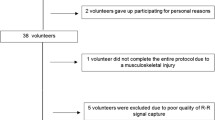Abstract
Benzodiazepines may induce hypotension by inhibiting the pressor response. Ephedrine has adrenergic effects on the circulation. After exercise, changes in cardiovascular control impair orthostatic tolerance. The impaired pressure response can be compensated for by chronotropic control of the heart. We studied the effect of midazolam and ephedrine on post-exercise cardiac autonomic chronotropic control in six 21-year-old female volunteers, who received single doses of 15 mg midazolam, 50 mg ephedrine, or placebo orally according to a placebo-controlled, double-blind, crossover design. After exercise, the subjects assumed the supine position for rest, then a−10° head-down position followed by a 70° head-up position. Power spectral analysis of heart rate variability for 7 min and steady-state brachial arterial blood pressure were measured in each position. After administration of midazolam, three subjects had an abnormal fall in their arterial blood pressure (with one presyncope) as a response to head-up tilt. Changes in heart rate variability exceeded those seen during placebo treatment (p<0.01) and involved oscillations, suggesting activation of both sympathetic and parasympathetic dynamics. After ephedrine administration, arterial blood pressure increased during head-down tilt, but parasympathetic dynamics to the heart were dampened. Head-up tilt induced increased sympathetic stimulation of the heart and a sympathicotonic cardiovascular response (p<0.01). In conclusion, midazolam induced unexpectedly great changes in dynamic cardiac control during cardiovascular stimulation. Ephedrine increased tonic sympathetic activity and stabilized the neural circulatory control of the heart by immobilizing dynamic parasympathetic activation.
Similar content being viewed by others
References
Reves JG, Fragen RJ, Vinik HR, Greenblatt DJ. Midazolam. Pharmacology and uses.Anesthesiology 1985;62:310–324.
Tilly-Kiesi M, Perttunen K, Somer T, Pentikäinen PJ. Midatsolaamin aiheuttama hengityksenpysähdys ja hypotensio.Duodecim 1989;105:61–64.
Marty J, Gauzit R, Lefevre Pet al. Effects of diazepam and midazolam on baroreflex control of heart rate and on sympathetic activity in humans.Anesth Analg 1986;65:113–119.
Adams P, Gelman S, Reves JG, Greenblatt DJ, Alvis JM, Bradley E. Midazolam pharmacodynamics and pharmacokinetics during acute hypovolemia.Anesthesiology 1985;63:140–146.
Hoyer I, Van Zwieten PA. The central hypotensive action of amphetamine, ephedrine, phentermine, chlorphentermine and fenfluramine.J Pharm Pharmac 1972;24:452–458.
Martin WR, Sloan JW, Sapira JD, Jasinski DR. Physiologic, subjective, and behavioral effects of amphetamine, methamphetamine, ephedrine, phenmetrazine, and methylphenidate in man.Clin Pharmacol Ther 1970;12:245–258.
Patrick JM, Dikshit MB, MacDonald IA, Fentem PH. Human orthostatic reflexes after taking temazepam at night.Br. J. Clin Pharmac 1987;24:799–807.
Sagawa K. Baroreflex control of systemic arterial pressure and vascular bed. In: Shepherd JT, Abboud FM, Geiger SR, eds.Handbook of Physiology, Section 2, The Cardiovascular System, Vol. III Bethesda, Maryland: American Physiological Society, 1983; 453–496.
Johnson RH, Lambie DG, Spalding JMK. Nervous control of the circulation. In:Neurocardiology. The Interrelationship Between Dysfunction in the Nervous and Cardiovascular Systems Ch. 1. London: W.B. Saunders Company, 1984;1–58.
Weise F, London GM, Guerin AP, Pannier BM, Elghozi J-L. Effect of head-down tilt on cardiovascular control in healthy subjects: a spectral analytic approach.Clin Sci 1995;88:87–93.
Aunola S, Rusko H. Reproducibility of aerobic and anaerobic thresholds in 20–50 year old men.Eur J Appl Physiol 1984;53:260–266.
Lindqvist A. Noninvasive methods to study autonomic nervous control of circulation.Acta Physiol Scand 1990;138 (suppl. 588):1–108.
Lindqvist A, Parviainen P, Kolari Pet al. A non-invasive method for testing neural circulatory control in man.Cardiovascular Res 1989;23:262–272.
Kirkendall WM, Burton AC, Epstein FH, Freis ED. Recommendations for human blood pressure determination by sphygmomanometers.Circulation 1967;36:980–988.
Thulesius O. Pathological classification and diagnosis of orthostatic hypotension.Cardiology 1976;61 (Suppl. 1):180–190.
Schubert E, Dinter W, Rielke W. Heart rate control and metabolic parameters after fatiguing exercise. In: Koepchen H-P, Huopaniemi T, edsCardiorespiratory and Motor Coordination, Berlin, Heidelberg: Springer-Verlag, 1991;300–306.
Mitchell JH. Neural control of the circulation during exercise.Med Sci Sport Exer 1990;22:141–154.
Harrison MH, Rittenhouse D, Greenleaf JE. Effect of posture on arterial baroreflex control of heart rate in humans.Eur J Appl Physiol 1986;55:367–373.
Steptoe A, Vögele C. Cardiac baroreflex function during postural change assessed using noninvasive spontaneous analysis in young men.Cardiovasc Res 1990;24:627–632
Okkola KT, Aranko K, Luurila Het al A potentially hazardous interaction between erythromycin and midazolam,Clin Pharmacol Ther 1993;53:298–305.
Strömberg C, Vanakoski J, Olkkola K, Lindqvist A, Seppälä T, Laitinen LA. Exercise alters the pharmacokinetics of midazolamClin Pharmacol Ther 1992;51:527–532.
Abi-Samra F, Maloney JD, Fouad-Tarazi FM, Castle LW. The usefulness of head-up tilt testing and hemodynamic investigation in the workup of syncope of unknown origin.Pace 1988;11:1202–1214.
Raviele A, Gasparini G, Di Pede F, Delise P, Bonso A, Piccolo E. Usefulness of head-up tilt test in evaluating patients with syncope of unknown origin and negative electrophysiologic study.Am J Cardiol 1990;65:1322–1327.
Rhoden KJ, Meldrum LA, Barmes PJ. Inhibition of cholinergic neurotransmission in human airways by β2-adrenoceptors.J Appl Physiol 1988;65:700–705
Hedman AE, Tahvanainen KUO, Hartikainen JEK, Hakumäki MOK. Effect of sympathetic modulation and sympatho-vagal interactions on heart rate variability in anaesthetized dogs.Acta Physiol Scand 1995;155:205–214.
Author information
Authors and Affiliations
Rights and permissions
About this article
Cite this article
Lindqvist, A., Jalonen, J., Laitinen, L.A. et al. The effects of midazolam and ephedrine on post-exercise autonomic chronotropic control of the heart in normal subjects. Clinical Autonomic Research 6, 343–349 (1996). https://doi.org/10.1007/BF02556305
Received:
Accepted:
Issue Date:
DOI: https://doi.org/10.1007/BF02556305




